Crimson
Brilliant_Rock
- Joined
- Apr 3, 2019
- Messages
- 1,255
Hello, I am starting this thread to share what I have learnt about evaluating jadeite (feicui).
Thanks, @Autumn in New England for the encouragement!
I know there are many jadeite buyers and owners here! Please feel free to share what you think and know about jadeite so we can make this a one -stop place for anyone interested in learning or evaluating jadeite.
In this thread, I will focus on type A jadeite, There are already many sources on differentiating between Types A,, B and C so I won’t go into that here. What I'd like to do is to share what I have read from Chinese sources and authorities about jadeite evaluation,
Jadeite post #1
Colour, the second most important factor.
Jadeite is often associated with the color green, but it also comes in other hues Some jadeite is colourless.
In the pic below, the colors are listed in the left column: brown, red, orange, yellow, Lu green, Qing green, blue, purple, pink, white, black and grey. In Chinese, there are two major words for green. Lu is a pure leaf green, and Qing a bit more bluish and darker. The second column from the left shows variations of Lu green, from pale spring green to, apple, pea, sunny, spicy, imperial, spinach and inky. Below the Lu green varieties , you will see the purple varieties, ranging from pinkish, purple to eggplant and lavender. At the upper part of the third column is Qing green, which is not as prized as Lu Green. From the top of the column, we have green and white, flowery green, dry green and petroleum or oily green. Below them are the blue varieties, Springwater, blue, sky, blue, lake blue and ink. At the bottom you will see ash grey and “black chicken” hues.

The image from Sohu.com below shows the colour factors that are important in Lu Green jadeite. The colour factors apply to other hues, too. From the left, the columns are:
Nong, which means saturation or intensity. The column goes down from high to low. Saturation is good but just as in other gems, over saturation can be a problem. At the bottom you see ,”colorless” piece 无色. This is desirable if the jadeite is clear as glass, without visible inclusions.
Xian Yang, meaning liveliness, vibrancy and brightness. As you go down the column, you will see decreasing/less desirable levels of vibrancy and liveliness.
Zheng, the extent to which the colour meets the highest standard — the desired shade of green. Besides imperial green, sun green is also highly regarded.
Cun - evenness of colour throughout the piece of jadeite. There should be no eye-visible darker orlighter patches or blotches, or inclusions such as “cotton” , dark impurities and brown stains.

It is commonly believed that the most important attribute of jadeite is color. However, the most important attribute is actually Zhong Sui , which translates literally as planting water. I have heard jadeite connoisseurs or “people in the inner circle” remark that those with knowledge and insight look for water first, and colour second, whereas novices focus on colour.
My next post will focus on Zhong Sui.


Thanks, @Autumn in New England for the encouragement!
I know there are many jadeite buyers and owners here! Please feel free to share what you think and know about jadeite so we can make this a one -stop place for anyone interested in learning or evaluating jadeite.
In this thread, I will focus on type A jadeite, There are already many sources on differentiating between Types A,, B and C so I won’t go into that here. What I'd like to do is to share what I have read from Chinese sources and authorities about jadeite evaluation,
Jadeite post #1
Colour, the second most important factor.
Jadeite is often associated with the color green, but it also comes in other hues Some jadeite is colourless.
In the pic below, the colors are listed in the left column: brown, red, orange, yellow, Lu green, Qing green, blue, purple, pink, white, black and grey. In Chinese, there are two major words for green. Lu is a pure leaf green, and Qing a bit more bluish and darker. The second column from the left shows variations of Lu green, from pale spring green to, apple, pea, sunny, spicy, imperial, spinach and inky. Below the Lu green varieties , you will see the purple varieties, ranging from pinkish, purple to eggplant and lavender. At the upper part of the third column is Qing green, which is not as prized as Lu Green. From the top of the column, we have green and white, flowery green, dry green and petroleum or oily green. Below them are the blue varieties, Springwater, blue, sky, blue, lake blue and ink. At the bottom you will see ash grey and “black chicken” hues.

The image from Sohu.com below shows the colour factors that are important in Lu Green jadeite. The colour factors apply to other hues, too. From the left, the columns are:
Nong, which means saturation or intensity. The column goes down from high to low. Saturation is good but just as in other gems, over saturation can be a problem. At the bottom you see ,”colorless” piece 无色. This is desirable if the jadeite is clear as glass, without visible inclusions.
Xian Yang, meaning liveliness, vibrancy and brightness. As you go down the column, you will see decreasing/less desirable levels of vibrancy and liveliness.
Zheng, the extent to which the colour meets the highest standard — the desired shade of green. Besides imperial green, sun green is also highly regarded.
Cun - evenness of colour throughout the piece of jadeite. There should be no eye-visible darker orlighter patches or blotches, or inclusions such as “cotton” , dark impurities and brown stains.

It is commonly believed that the most important attribute of jadeite is color. However, the most important attribute is actually Zhong Sui , which translates literally as planting water. I have heard jadeite connoisseurs or “people in the inner circle” remark that those with knowledge and insight look for water first, and colour second, whereas novices focus on colour.
My next post will focus on Zhong Sui.







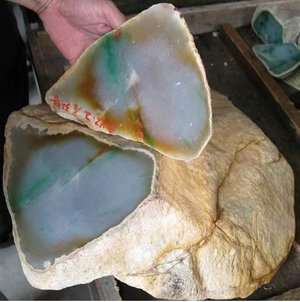











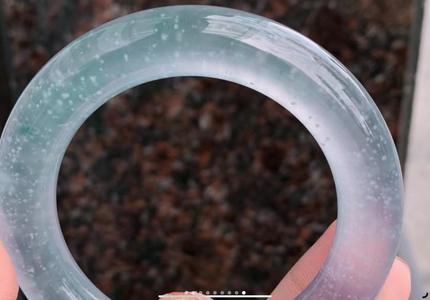




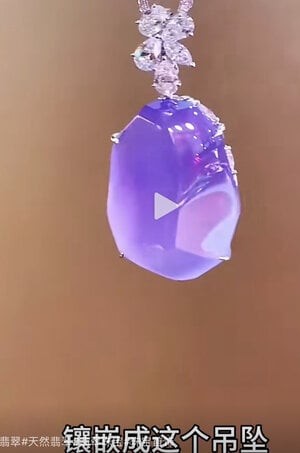







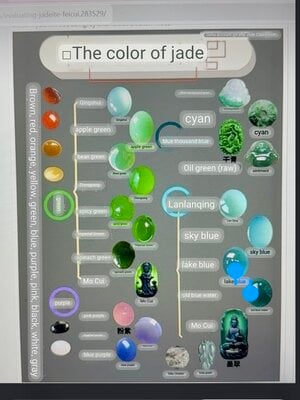

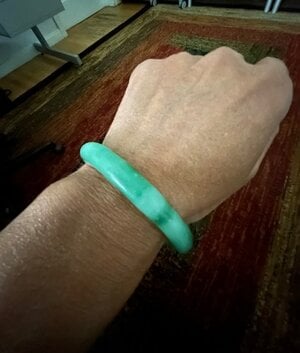


300x240.png)